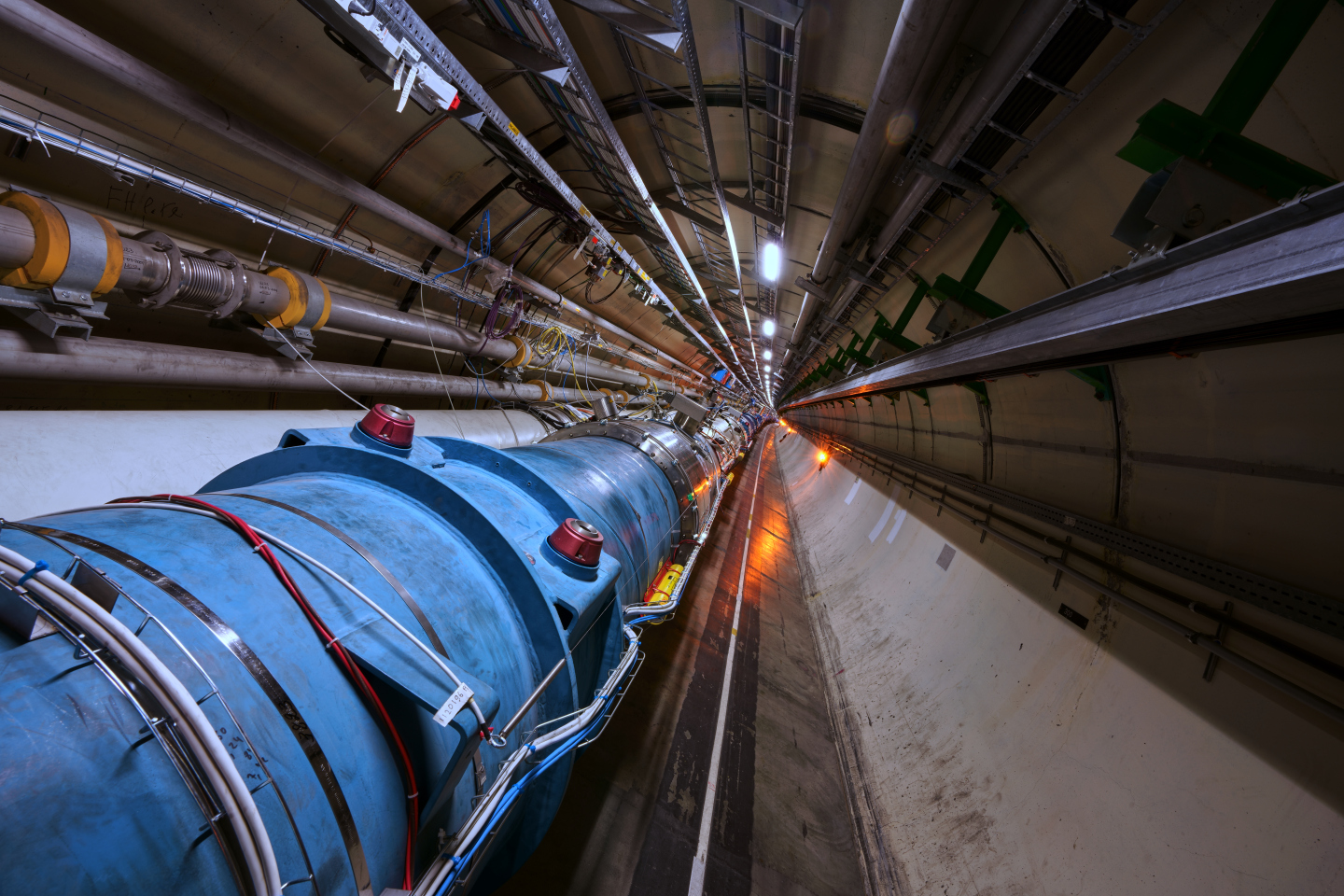The World's Largest Atom Smasher Could Be Tweaked to Hunt 'Dark World' Particles

Scientists may have a new way to peer into physics' "dark world."
In a new paper, theoretical physicists say they have a new plan for searching for theoretical particles that, so far, have never been observed. These particles, dubbed long-lived particles, or LLPs, could be a window into dark matter and dark energy, which together make up 95% of the universe. Dark matter exerts a gravitational pull on ordinary matter, and dark energy is thought to cause the universe's expansion to accelerate. But neither can be directly observed, because any interactions they have with the luminous matter of the universe are feeble, said Zhen Liu, a postdoctoral researcher at the University of Maryland.
"They don't talk to us," Liu, one of the researchers who is working on the new plan, told Live Science.
But LLPs might provide a way for that dark world to communicate with the lighter one. And Liu and his colleagues believe that by tweaking some of the detectors in the world's largest atom smasher, the Large Hadron Collider (LHC) near Geneva, Switzerland, physicists might be able to find them. [The 11 Biggest Unanswered Questions About Dark Matter]
Parallel worlds
The "dark world," also known as the "hidden sector," describes a set of hypothetical particles that would go beyond the Standard Model of physics. (The Standard Model explains protons, neutrons, electrons and all the strange subatomic particles that go along with them, such as quarks, muons, neutrinos and the Higgs boson.)
If all the "normal" matter is in one valley, the dark world is in a parallel valley one ridge over, Liu said. It takes a tremendous amount of energy to climb that ridge, so particles in the dark world valley interact strongly with each other, but only slightly with those on the other side of the mountain. But some particles might be able to pass through that energy barrier from the dark world into the one we normally encounter via a process called quantum tunneling. These particles probably wouldn't be the dark-matter equivalents of stable particles like protons or neutrons, Liu said, but would perhaps be more akin to more unstable Standard Model particles.
It's those tunneling particles that the researchers are interested in finding. But these particles, if they exist, are rare, said Liantao Wang, a theoretical physicist at the University of Chicago. The LHC flings protons at one another at a dizzying pace, producing 1 billion collisions per second. Those collisions shatter the protons into massive numbers of known, Standard-Model particles. For scientists looking for the hidden sector, all those particles are mere noise. The particles they're interested in, Wang said, might appear only a few times a decade.
Get the Space.com Newsletter
Breaking space news, the latest updates on rocket launches, skywatching events and more!
A new path
Wang, along with Liu and their colleague, Jia Liu, are the authors of the new paper, published April 3 in the journal Physical Review Letters, suggesting a way to catch a glimpse of these rare particles.
It all comes down to timing. LLPs, Wang said, should be massive and lumbering compared to the Standard-Model particles that the LHC creates in bulk. Their slowness is because of the big energy hurdle they have to overcome just to make an impression on the world of normal matter, Liu said. But their snail's pace is also a useful feature for physicists. Most of the elementary particles in the LHC travel at the speed of light and decay rapidly. The Higgs boson, for example, is gone in a mere 10 to the minus 22 seconds, transforming into a set of more stable particles. [Photos: The World's Largest Atom Smasher (LHC)]
LLPs, though, should live slow — up to a tenth of a second, Wang said. They also travel slower than the speed of light. Therefore, adjusting the LHC's detectors to look for particles that arrive late to their sensors should be the key to detecting them.
"It's a very simple idea," Wang said, "but it turns out to be surprisingly effective."
Some of those adjustments will come naturally with the LHC's upgrades, which are ongoing now, Liu said. The particle collider will open again in 2021, with detectors that will be able to measure the timing of a particle's arrival 10 times more precisely than it currently can, he said. From there, he said, it's just a matter of a few software tweaks to take advantage of the LHC's capabilities, and making sure that the experimental physicists that use the collider prioritize the search. Now, Wang and Liu said, they and their experimentalist colleagues are having a series of meetings to make sure everyone's on the same page.
"It's going to happen," Liu said.
- Strange Quarks and Muons, Oh My! Nature's Tiniest Particles Dissected
- What's That? Your Physics Questions Answered
- 18 Times Quantum Particles Blew Our Minds
Originally published on Live Science.
Join our Space Forums to keep talking space on the latest missions, night sky and more! And if you have a news tip, correction or comment, let us know at: community@space.com.

Stephanie Pappas is a contributing writer for Space.com sister site Live Science, covering topics ranging from geoscience to archaeology to the human brain and behavior. She was previously a senior writer for Live Science but is now a freelancer based in Denver, Colorado, and regularly contributes to Scientific American and The Monitor, the monthly magazine of the American Psychological Association. Stephanie received a bachelor's degree in psychology from the University of South Carolina and a graduate certificate in science communication from the University of California, Santa Cruz.










